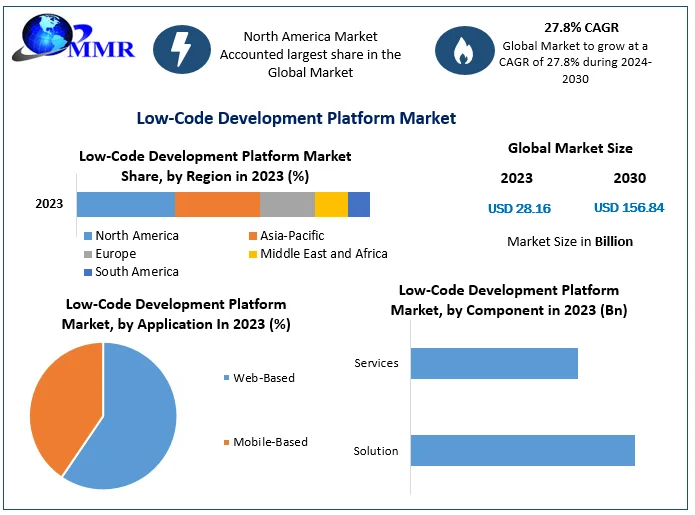Handy News On Choosing Low-Code Platform Info
Wiki Article
Benefits Of Developing Applications Using Low-Code In Terms Of Accessibility For Non-Developers
Low-code apps improve accessibility by non-developers (often referred to as "citizen-developers") because of certain key aspects.
Drag-and -Drop Builders. Low-code platforms include drag-and-drop interfaces. This allows non-developers the ability to create applications visually, without writing code. This makes it easier for those with less technical backgrounds to get involved in the process of development.
WYSIWYG editor: "What you see is the result you will get" editors allow users to design interfaces, workflows, and other features in a manner that is similar to the final product. They are easier to understand and to use.
Simplified Design of Logic and Workflow
Visual Workflow Modeling: Users can use visual workflow to create business processes, applications logic and flowcharts through diagrams and visually-designed flowcharts. These techniques are more intuitive than the traditional methods of coding.
Pre-built Components of Logic: Low-code platform often includes already-built logic (e.g. loops, conditional statement) that are easily set up, eliminating the need for complex programming.
Reusable Components & Templates
Library of Prebuilt Templates: Low-code platforms usually offer libraries of templates for popular application types. This allows non-developers the possibility of starting with a solid basis and customize it as required.
Reusable widgets and modules The process of creating a website is simplified through the use of reusable components and modules. This means that there is less need for deep technical knowledge.
Guided Development & Tutorials
Step-by-Step Guides: Platforms frequently provide guided development pathways or online tutorials on-screen directions to help users who aren't developers to create applications.
Interactive Tutorials Interactive tutorials that let you interact with the platform can help you learn and gain confidence.
Integration with existing tools
Seamless Integration - Low-code systems are easily integrated into existing systems and tools for business (e.g. ERP CRM, ERP) which gives even non-developers the ability to create apps that fit within their workflows.
APIs/Connectors: The APIs/Connectors built-in enable non-developers to connect their apps to external services.
Collaboration Features:
Team Collaboration Features, such as real time collaboration and shared workspaces, allow non-developers and professionals to work together effectively.
Role-based Access Control: Developers can be assigned specific roles, with the adequate access levels to ensure that they can participate in the process of development without having to compromise security or function.
Automated Tests and Debugging
Low-code platforms usually come with a built-in testing and debugging tools that makes this process easier. Non-developers are now able to ensure their application works correctly.
Error Highlighting - If issues occur, the system highlights them and suggests solutions, while guiding users through the process of troubleshooting.
Overall, the main advantage of developing applications using low-code for non-developers is due to its ability to decentralize the process of developing. Through providing clear, intuitive tools and guided experiences, low-code applications allow users of business to be actively involved in the creation and maintaining apps, thus bridging the gap between business requirements and the technical implementation. View the recommended Low-code Platform for application development info for site examples including multiplatform mobile app development, push alerts, push notifications android, develop web app, app dev platform, cloud software applications, microsoft azure sql, cross platform app dev, azure sql, rapid application design and more.

Benefits Of Application Development With Low-Code In Security And Governance
Low-code development can bring many advantages regarding security and governance. They are essential to ensure that apps are safe, secure and well-managed through their entire lifecycle. Here are a few key advantages.
Unified Management Console (UMC): Low-code applications typically offer a central management console where administrators can oversee and manage all the applications and ensure that they have a consistent management system across the organization.
Role-Based Access Control (RBAC) The majority of these platforms offer robust role-based access control, allowing administrators to define and enforce access policy. Only authorized users are permitted to modify and access specific areas of an application.
Compliance and Regulatory Adherence
Built-in Compliance Features: A lot of low-code platforms are built to conform to industry norms and regulations (e.g. GDPR, HIPAA). They offer frameworks and tools to ensure that the applications are compliant with specifications.
Audit Trails and Logging: Complete audit trails and logging are usually integrated, allowing organizations to keep track of changes, monitor access, and ensure compliance with internal and external laws.
Increased Security Measures
Data Encryption: Low-code platforms generally provide encryption built-in for data in transit and during transit, which ensures that sensitive information is protected.
Security Certifications – Many lowcode providers have security certificates, like ISO 27001 (or SOC2) which proves the compliance to the highest security standards. The customers can be confident that these companies adhere to the standards.
Automated Security Updates
Regular Security Updates and Patches Low-code platforms manage automatic security updates, patches and updates. Applications are therefore protected from current threats without requiring developer intervention manually.
Security Monitoring: Continuous monitoring of security tools are usually provided, providing real-time alerts as well as insights into security concerns that could be a problem.
Data Governance
Data Access Policies These platforms assist organizations define and implement their data access policies to ensure that only authorized users have access to the data and that it's being used appropriately.
Data Masking Anonymization Data Masking Tools: Built-in data masking tools and features to anonymize data help protect sensitive information, particularly in testing and development environments.
Consistent Lifecycle Management of Applications:
Pipelines for development and delivery: Low-code platforms typically include integrated development pipelines as well as delivery pipelines which incorporate security checks. Security is guaranteed throughout the entire lifecycle.
Version Control: A unified version control system helps to track changes and allows any modifications that are made to an application to be tracked. If required the changes can be reversed and the application's integrity maintained.
User Authentication, Authorization, and Authorization
Single Sign-On (SSO) Support for single sign-on and other advanced authentication mechanisms makes managing users easier and increases security.
Multi-Factor Authentication – Many platforms have built-in functions for multi-factor authentication, providing an additional layer of security.
Policy Enforcement and Compliance:
Low-code platforms are often designed with policies that are pre-defined to help organizations implement security and governance policies quickly.
Tools for Compliance Monitoring: These tools monitor and report continuously on the status of compliance. They allow you to find issues and tackle them in a proactive manner.
Integration into Existing Security Infrastructure
Seamless Integration: Low-code platforms have been designed to work with current security tools and infrastructure, like identity management systems and SIEM (Security Information and Event Management) solutions, and firewalls.
API Security: API features that protect data and maintain the integrity of the application are integrated into the API.
Best practices and training:
A lot of platforms provide guidelines and best practice for developing secure applications. They assist non-developers to meet security standards.
Security Training Some low code providers offer security tools and training for users in order to help them understand how to maintain and build secure applications.
All in all, low-code app developers offer security and governance advantage which allows them to create and manage their apps in a controlled, regulated and secure way. These platforms offer the frameworks and tools necessary to safeguard sensitive information and enforce policies, while ensuring regulatory compliance. Read the top rated Enterprise application development with Low-code Platform recommendations for site tips including rad application development, cross platform app development, app platforms, software for app development, driver jdbc, azure sql, app modernization, developing mobile apps, sso azure, paas service and more.

Benefits Of Low-Code Application Development In Collaboration And Workflow
Low-code application development is a great choice for businesses who want to boost team productivity through streamlining development processes. Here are the top advantages: Improved Cross-Functional Collaboration:
Unified Development Environment (UDE): Low-code platforms offer one, unifying development environment that allows everyone in the team, including developers and business analysts, to work together efficiently. This reduces silos and promotes better communication.
Visual Development Visual Development: The low-code platform's visually drag-and-drop capabilities make it simple for nontechnical team participants to participate in the design process. It also ensures business requirements are captured correctly and implemented.
Communication Enhanced:
Real-Time Collaboration: A lot of low-code platforms offer real-time collaboration options, such as the simultaneous editing of comments, and instant feedback. These features facilitate continuous communication and reduce the time spent on back-and-forth discussions.
Shared workspaces. Teams are able to collaborate through shared workspaces. There, they are able to review, edit, and debate various project elements.
Streamlined Workflow
Project management tools that are built-in Low-code platforms typically come with project management tools that allow teams to plan, track and manage their projects. This includes the assignment of tasks, tracking progress, deadline management and much more.
Workflow Automation: Automating repetitive tasks and workflows can reduce the manual effort and mistakes and allows teams to focus on more strategic tasks and improving overall efficiency.
Speedier Iteration Cycles:
Rapid Prototyping Low-Code platforms are great for speedy prototyping. Iterative development is also possible, allowing the team to develop, test and improve their apps within shorter time. This allows feedback to be incorporated quickly and changes made rapidly.
Support for Agile Methodologies Using agile practices gives teams the ability to work in sprints and continuously deliver small amounts of functionality that make it easier to adapt to the changing demands.
Accessibility for Non-Developers:
Citizen Development: Low-code platforms allow users in the business (citizen developers) to design and develop applications without requiring a lot of coding experience. This eases the workload of IT and development teams and helps them react quicker to the needs of business.
Training and onboarding. Tools that are intuitive and comprehensive training materials can help a new team member get up-to-speed and increase the overall level of collaboration.
Centralized Documentation and Knowledge Sharing
Integrated Documentation: Low-code platforms often include features to maintain and create documentation within the platform itself and ensuring that all project information is easily accessible and centrally located.
Knowledge Repositories: Teams may develop and maintain knowledge repositories that include best practices, templates, and reusable components, which aid in sharing of knowledge and reducing the duplication of effort.
Consistency and Standardization
Standardized components: Standardized components, built in advance, ensures uniformity in the applications. Team members can comprehend and work with greater ease on different parts.
Compliance and governance Governance and compliance frameworks that are built-in to assure that all applications are created in line with organizational standards, regulatory requirements and standards for quality. They minimize the chance of not complying and guarantee that applications meet specifications.
Feedback and Improvement
Integrated Feedback Low-code platforms offer users with integrated feedback mechanisms that enable them to provide feedback easily on applications. The feedback is then incorporated into the application development process.
Continuous Improvement: The capacity to rapidly test and deploy changes based on feedback assures constant improvement of software that are in line with the needs of users and business objectives.
Visualization and Reporting
Real-Time Analyses: The built-in reporting and analytics tools provide instantaneous insight into the project's performance, development and user interaction, allowing to make data-driven choices.
Visual Workflow Maps Software for mapping workflows or processes are useful for teams to understand their workflows. They can also be used to pinpoint bottlenecks, and areas that need improvement.
Low-code development of applications is a powerful tool to collaborate and streamline workflow. It brings together different teams, simplifies communication and streamlines processes. This creates a more flexible, collaborative and efficient environment for development. This eventually results in better-quality applications as well as better alignment of business objectives.
